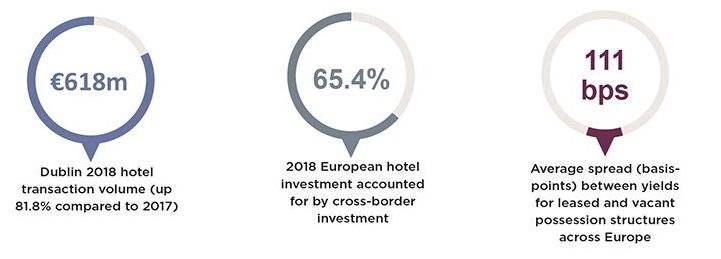Where are the value opportunities beyond leased assets in Europe’s core destination cities?
Cross-border buyers continue to drive the majority of hotel investment across Europe
European hotel transaction volumes remained high in 2018, exceeding that of 2017 according to RCA. Cross-border investors made up the lion’s share of transactions, to account for a 65.4% share of total volumes in 2018, outstripping the 10- year average of 54.9%. Overseas investment into UK hotels form a bulk of this, owed to multiple large-scale portfolio transactions involving Canadian, Israeli and French buyers.
By city, London continues to lead in terms of investment volumes, exceeding the previous 2013 peak by 10.2%. Paris saw the second highest hotel volumes transacted in 2018, off the back of a relatively muted year in 2017. This included key deals such as the 428-room Westin Paris, acquired by Henderson Park for £489.4m in October 2018. Amsterdam and Frankfurt also feature within the top five investment markets of 2018. High volumes of transactions in these mature markets has maintained relatively keen yields.
For those willing to move up the risk curve, emerging tourist cities and non-leased operating structures offer attractive yields
Savills Research
.jpg)
European city hotel prime yield comparison
Source: Savills Research
Growth cities and alternative operating structures offers attractive higher yielding
The chart above outlines the spread in terms of prime indicative yields across the differing European cities and operating structures. For example, prime leased hotel yields in Paris are the keenest at 3.50%, with prime hotel yields on the same operating structure 25bps higher in Munich.
Investor appetite for leased hotels in mature markets such as Germany, Paris, Amsterdam and London has resulted in compression and very keen relative pricing. In some markets, such as London where the demand fundamentals remain robust, we have seen this investor appetite move up the yield curve with the spread between leased and VP (vacant possession) structures squeezed to 75bps. We are still to see the same squeeze in other mature markets particularly those that have the ability to drive RevPAR. For example, the leased to VP spread in Munich and Amsterdam stands at 100bps and 125bps respectively.
Emerging tourist markets are also looking increasingly attractive for those investors looking for higher relative yields. Leased hotel yields in Dublin are 75bps higher than those in Paris. Dublin’s leased to VP spread is a further 175bps. This is against a backdrop where Dublin has been one of the strongest RevPAR growth cities across Europe over recent years, helped by a very constrained development pipeline. Unsurprisingly, it has seen strong transaction activity with volumes up 81.8% to €618 million in 2018.
Spain has seen significant investment activity over the last five years (partly due to Blackstone acquiring Hispania, becoming the country’s largest hotel owner). While this has helped to compress yields in Madrid, Barcelona has witnessed some softening down to reduced investor sentiment off the back of political instability and security threats. However, the market fundamentals remain strong with overseas arrivals increasing 5.2% in 2018. Furthermore, the ban on future central hotel development minimises a potential pipeline risk, which should help to support pricing.
Hotel investment outlook in key Portuguese markets remains strong given recent RevPAR growth and rapidly expanding tourism industries. Additionally, the Portuguese government recently passed a law allowing REITs to operate in Portugal, potentially driving future investment demand.

An increasing international hotel brand presence will help to legitimise hotel investment in emerging cities
The growth in tourism to smaller emerging cities across Europe is helping to drive stock growth, enticing global brands into these previously under-served markets. A growing presence of global brands will help to improve the appeal of these cities to investors, while also increasing acquisition opportunities. While, this has and will create some operational headwinds in certain markets (Warsaw being a prime example), for those cities with more constrained development opportunities the impact on operational performance will be less pronounced.
.jpg)